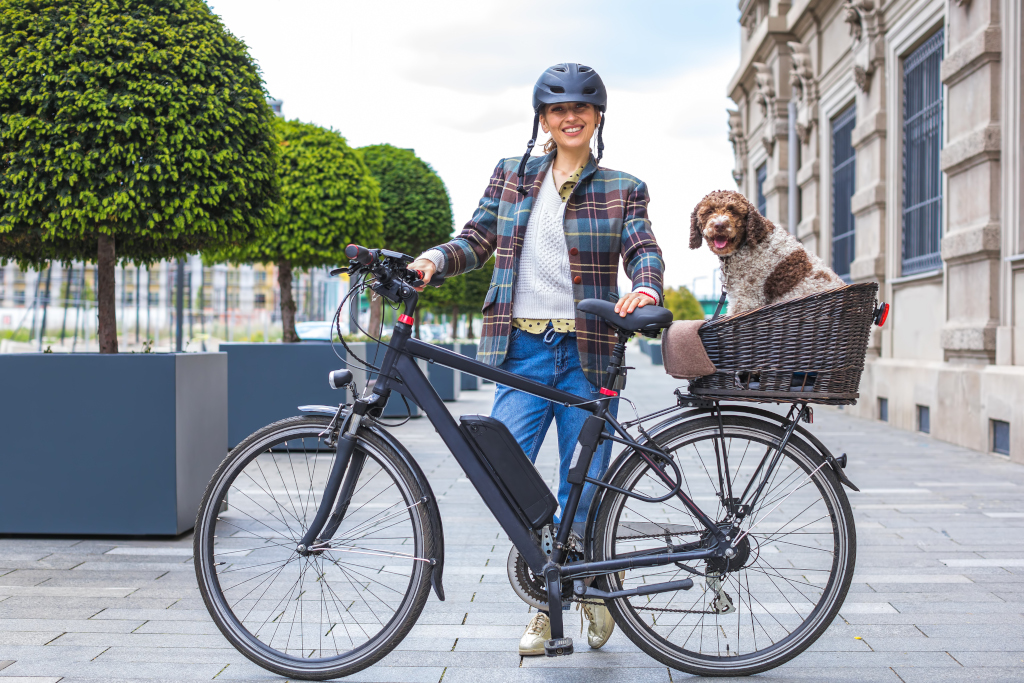
If you are both a dog parent and cyclist wondering if it is possible to take your furry friend with you on two wheels, the answer is yes!
Not only can biking with dogs help both you and your pup get some much-needed exercise, but it can also be a fun bonding experience. However, before hitting the road with your four-legged companion in tow, there are a few things you should keep in mind to ensure a safe, fun ride!
And before we get into our top tips for safe cycling with dogs, let’s first start with the two common questions, is biking with dogs safe, and is it legal, as well as some of the things you need to know when it comes to biking with dogs.
Is It Safe to Bike With Dogs?
If someone tells you that taking your dog out on a bike ride is 100% safe, they are probably not being completely honest, or they haven’t actually thought about it whatsoever. As with any outdoor activity, whether it be biking, camping, hiking, or running with dogs, there are always risks involved.
I’ll give you a few examples of the potential risks of cycling with dogs. First, your dog could get spooked by other cyclists, cars, or pedestrians and dart out into the road, putting you both in danger. Second, not properly securing your pup who’s riding in a bike basket could result in them falling off and getting hurt. And third, biking with a large dog that hasn’t been taught impulse control and properly trained to run alongside a bicycle may potentially chase after cars or other animals, which could pull you off balance. And the list goes on. My point here is that there are definitely risks involved, and all of these are valid concerns.
While there are no guarantees that an accident won’t happen, there are certain precautions you can take to greatly reduce the chances of anything bad happening and make biking with your pooch as safe as possible. This includes outfitting your furry cycling partner with proper dog biking gear, using common sense, and being aware of your surroundings. We’ll go into more about this later.
What Does the Law Say About Riding a Bike With a Dog? Is it Legal?
There are currently no laws in the United States preventing pet owners from cycling with dogs. So the answer to that is, yes, it is perfectly legal to ride a bike with your canine so long as your dog is under control and you’re not endangering other road users.
One thing, though, there could be leash laws that require all dogs to be on a leash when in public, depending on where you live. This essentially makes biking with dogs off-leash illegal, and as you can imagine, it’s also quite dangerous. Of course, there are also bicycle laws you have to adhere to, regardless if you are bringing your pup along with you. So make sure you’re aware of all cycling rules in your area before taking your fido out for a spin!
Is Your Canine a Good Candidate for Biking?
When it comes to biking with dogs, there are essentially two types. The first is where your dog runs alongside you as you’re cycling, while the second is where your pup rides in a carrier, whether that’s in a bike trailer, bike basket, or a dog backpack carrier.
And as you can imagine, not all dogs are good candidates for running alongside a bicycle. Small- and medium-sized dogs are generally not suitable for this activity as they may have trouble keeping up the pace because of their short legs. Brachycephalic breeds, or dogs with a short snout, like Bulldogs and Pugs, are also not the ideal cycling partners, and that’s because they will have a hard time breathing when engaging in vigorous physical activities, especially in hot weather. Elderly dogs or those with health issues or mobility problems aren’t suitable for running alongside you either for the apparent reason. In these scenarios, it would be best to invest in a dog bike carrier. This way, they can come along for the ride without doing any of the work!
As for pups who ride in a carrier, although any size or breed of dog can technically do this, some dogs don’t enjoy being towed. So before strapping your pooch into a carrier, make sure to train them and get them accustomed to riding in one to ensure they are comfortable with it and won’t be stressed out by the experience.
You May Also Like: The 7 Worst Trail Running Breeds
So What Makes a Dog Suitable for Running Alongside Bicycles?
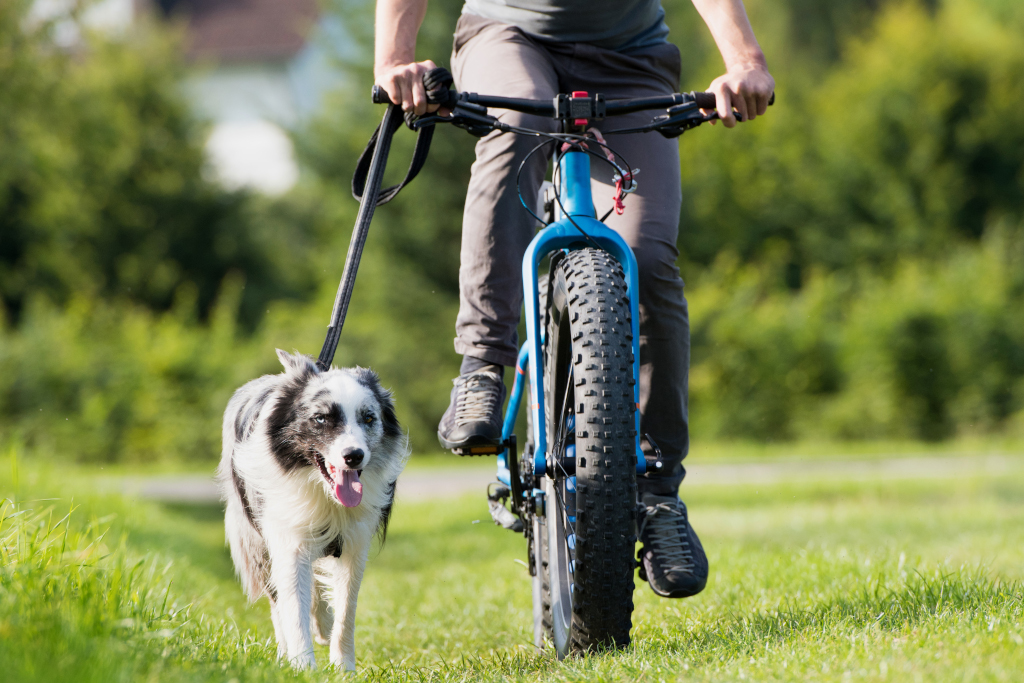
Your dog’s breed matters. If you have a large, adventurous canine who loves being outdoors and exploring new places, chances are they will love running alongside your bicycle! In fact, the best dogs for cycling with are larger breeds that have lots of energy and enjoy running and exploring, for instance, Vizslas, German Shorthaired Pointers, Weimaraners, and Border Collies.
In addition to size and energy level, your dog’s age is also an important consideration. Senior dogs, for instance, may not have the energy or stamina for such rigorous activity. And while puppies are full of energy, they still have developing bones and joints, so they shouldn’t be out running alongside a bike until they’re fully grown, typically around 1 to 1.5 years of age.
And as I briefly mentioned earlier, dogs with health issues aren’t the best candidates for biking. All running dogs should be in good health before being brought on a bike ride. So make sure your pup gets a clean bill of health from your vet before lacing up your sneakers and hitting the pavement with them!
It’s also crucial that your dog is well-behaved before hitting the road, meaning your fido should know the basic commands, such as sit, stay, come, leave it, and heel. They should also know the directional and speed cues, have a good recall (i.e., come when called), be non-reactive to other dogs and cyclists, and are comfortable running on a leash without pulling or lunging. If your dog isn’t a good canine citizen, biking with them will put you both at risk.
In short, your canine should have the necessary traits, be physically fit, and already know how to run alongside you nicely. We have an article on how to train your dog to run with you and a running training plan to help get your canine in shape, be sure to check them out!
You May Also Like: Guide to Getting Started in Cross-Country Running With Dogs
How Long or Far Can You Bike With Dogs?
You probably wonder how long or far you can bike with your dog if you plan to ride long distances. Unfortunately, there is no definitive answer to this question. It varies depending on the individual dog’s fitness level, age, breed, size, health condition, the type of terrain, and the weather condition.
For instance, a young adult dog will be able to bike much longer distances than an older breed dog who isn’t as fit. A healthy dog who has been conditioned to run long distances will also be able to bike further than one who isn’t used to running. And dogs who are more susceptible to heatstroke will need to take more breaks on hot days than those who can tolerate the heat better, which means they won’t be able to cover as much ground.
As a general rule of thumb, it’s best to start short and slow and gradually increase the distance and duration of your rides as your dog builds up their endurance and stamina. For most dogs, this means taking short rides around the neighborhood at first, then gradually working up to longer rides as they get more comfortable with the activity.
You May Also Like: How Far is Too Far to Run With Your Canine?
Get the Right Biking Gear & Accessories for Dogs
So your dog makes a good candidate for running alongside your bike, and you’re ready to take them out for a spin! That’s great news. But before you hit the road, just like human cyclists, it’s crucial to get them outfitted with the proper gear! Here’s a list of essential dog biking equipment your canine needs:
1. A Dog Bike Leash
Of course, the first thing you need is a dog bicycle leash! If you’re thinking of just using a standard leash, I’m sorry to say that that’s a big no-no. Why? Because standard leashes are too long and give your dog too much slack, which can be dangerous. They also leave your dog vulnerable to getting tangled. So while a standard leash will work in a pinch, it’s not the safest option.
There are specialized leashes explicitly designed for biking with dogs. These dog bike leashes are more suitable for cycling with dogs as they have a more durable design that can withstand wear and tear. And instead of needing you to hold onto anything, they attach to your bicycle, giving you more control over the bike to keep you and your pup safe.
These bike leashes for dogs also have a smart, unique design that keeps your furry friend safely distance from the wheels while they run alongside you and can prevent side pulling, tipping, and tangling. Some higher-end ones like the Walky Dog Plus Hands-Free Dog Bicycle Exerciser Leash even come equipped with an internal spring system, essentially a built-in shock absorber to help reduce the impact when your canine pulls, tugs, turns, or suddenly stops.
2. A Well-Fitting Dog Harness for Running
Another key piece of gear for cycling with dogs is a proper-fitting harness. I don’t recommend using a dog collar as it may cause injuries to your pup’s throat and neck area if they suddenly stop while running at high speed.
There aren’t special harnesses for biking, though, unless we’re talking about bikejoring, which is a different sport altogether. So your best option here is to use a dog running harness simply because they’re lightweight, distribute the force of any sudden stops evenly across a dog’s body, and won’t restrict movement, making them comfortable for running dogs to wear.
It’s a good idea to choose harnesses with reflective strips or patches to help make your dog more visible in low-light conditions. And you’ll also want to ensure that the one you purchase fits your canine properly. It should be snug but not too tight to keep it from chafing or rubbing your dog’s skin. The last thing you want is your pup to be in pain or discomfort when they’re out biking with you, so carefully measure your furry cycling buddy!
3. Dog Water Bottle
Like humans, dogs need to stay hydrated when exercising, especially in hot weather. So make sure to bring plenty of water for your pup!
Although you can bring a regular water bottle and collapsible bowl, I personally prefer specially designed dog water bottles. These special bottles have a built-in bowl, which can help you save space and make it easier to give your dog a drink while on the go. They’re also usually made with durable, BPA-free materials and have a clip you can attach to your pack.
You May Also Like: How Much Water Does Your Dog Need?
4. Poop Bags
Last but not least, don’t forget the poop bags! Because you never know when your dog will need to answer nature’s call.
It’s always essential to clean up after your dog no matter where you are because, after all, nobody wants to step in dog poop. And let’s face it, no one wants dog poop getting on their bike! So be considerate and responsible. Also, some states and cities have laws that require pet owners to dispose of their pets’ wastes. So it is not only the right thing to do, but you could also avoid getting a ticket or fine!
And if you’re anything like me, bring the biodegradable ones. These are eco-friendly and will decompose much quicker, which is much better for the environment than those regular plastic bags.
Optional Dog Biking Equipment
There are a few other things that you may want to consider bringing along when biking with your dog. They’re nice to have, so they aren’t necessarily required but can definitely make the experience more enjoyable and safer for your four-legged biking partner.
1. Dog GPS Tracker
If you think the only purpose of me asking you to bring a dog GPS tracker is because it allows you to keep track of where your canine goes, then you’re wrong. GPS trackers these days can not only help locate dogs if they happen to run off or get lost, but some of them also come with a built-in fitness tracker.
What that essentially means for you is you can monitor your dog’s activity level, ensuring you won’t over-exert them and risk injury. And if you’re training for a race or competition, this data can help you better gauge your canine’s performance and adjust your expectations accordingly.
You May Also Like: Is Whistle Go Explore or PetFON Dog Tracker Better?
2. Dog Boots
Another optional piece of equipment you may want to consider is dog boots. I know this may seem silly, but they can be pretty helpful, especially if you’ll be riding on rough terrain.
Boots can help protect your pooch’s feet from sticks, stones, sharp rocks, glass, and hot pavement in the summertime and prevent frostbite in winter. Plus, they can help keep your dog’s paws clean and dry if you happen to ride through some mud puddles or puddles of water!
There are many different dog boots on the market, from those made explicitly for off-road adventures to winter ones that help keep your pup’s feet warm and dry in the snow. Make sure to choose the right type of boots and get ones that fit snugly and are comfortable for your dog to wear.
Getting a dog into boots is no easy feat, though, and it may take multiple tries (and treats!) to get them used to it! In fact, it can be quite a challenge at first. So be prepared for a bit of a struggle and some dirty looks from your furry friend. If they’re genuinely resistant to the idea, consider using paw wax instead.
You May Also Like: 8 Easy Ways to Protect Your Dog’s Paws!
3. Cooling Vest/ Warm Jacket
Depending on the climate you live in, and the time of year, you may want to consider bringing along either a cooling vest or warm jacket for your dog.
A cooling vest is just as its name suggests, a vest that helps keep dogs cool, ultimately preventing heatstroke. This can be helpful on hot days or if you’re going to be doing a lot of uphill biking, as your dog will likely get hotter much quicker.
On the other hand, a warm jacket for dogs is great for those cold winter rides! It’s especially crucial for short-haired breeds since they don’t have as much fur to insulate them against the cold weather.
You May Also Like: Top 17 Winter Safety Tips for Dogs
4. A Normal Dog Leash
In addition to your bike leash, you should also consider bringing along either a regular dog leash, a retractable leash, or a hands-free dog leash.
Why? Well, because there may be times you need to make a quick pit stop, like if you need to use the restroom or want to grab a bite to eat. Or, if you’re planning on doing some hiking or exploring off the beaten path, these normal leashes will come in handy.
5. First Aid Kit for Dogs
You may never need it, but it’s always better to be safe than sorry. So consider bringing a first aid kit designed specifically for dogs when biking with them (or really anytime you’re embarking on any outdoor adventure with your furry friend). This way, if your canine does injure themselves, you have everything you need to treat them right away.
And, of course, you would also need to know how to use the items in the kit! So always do your research, read up on some basics, and learn how to properly administer first aid to dogs before heading out on your ride.
You May Also Like: Things to Add to Your Doggy First Aid Kit
Dog Cycling Gear Checklist
Essentials
Optional
Clothing/ Accessories for Hot Weather Biking
Clothing/ Accessories for Cold Weather Biking
Miscellaneous
What Else You Need to Know About Riding a Bike With Your Dog
Now that you know what equipment you need and some basics about cycling with your canine, there are just a few more things to keep in mind.
- Choose the Right Bike. If you are going to be biking with your dog regularly, it is crucial to choose a bike that is comfortable and easy to ride. Though I’m no bike expert, and unless you plan on doing some serious mountain biking or cycle touring, I would recommend getting a hybrid bike. They are designed to be ridden on various terrain, from city streets to dirt trails, making them suitable for those who want to bike with their dogs off-road and on-road.
- Get Your Pup Used to Be Around Your Bicycle. Running next to a bicycle could be a little daunting for dogs, especially for those who have never done it before. So, it’s vital to properly introduce them to your bike and make sure they are comfortable being around it. Start by simply letting them sniff and investigate your bike while parked. Once they’re comfortable with that, you can then take things up a notch and introduce them to walking alongside the bicycle. And as they become more comfortable and confident, it’s time to take them on bike rides! If your pup seems scared or uncomfortable at any point, it is best to stop and give them some time to adjust.
- Start Slow and Increase Speed and Distance Gradually. Just like you wouldn’t run a marathon with your dog on your first day of running together, you shouldn’t try to ride 10 miles on your first bike ride together! Instead, start by taking short rides around the block or in a park and gradually increase your rides’ distance, difficulty, and duration as they build up their endurance and strength.
- Inspect Your Bike Before Each Ride. This is a good habit to get into, even if you’re not biking with your dog. Always take a few minutes to give your bike a once-over before each ride. Check the air pressure in your tires, make sure your brakes and reflectors are working properly, and give the chain a quick lube.
- Ensure Your Canine is Properly Outfitted. Just like you need proper equipment for a safe and comfortable ride, so does your dog! So make sure to download a copy of our free dog biking gear checklist to ensure you have everything you need to keep your pup safe on your rides. And before every ride, take a quick moment to check that their gear is secure and properly fitted.
- Keep a Close Eye on Your Furry Biking Partner. Always keep an eye on your dog and pay attention to their body language while you’re riding to ensure they are happy and comfortable. If they start to lag behind or seem off or distressed in any way, it’s best to stop and check on them.
- Be Aware of Your Surroundings. Always be aware of your surroundings and look out for hazards, including potholes, parked cars, roundabouts, etc., and be extra vigilant when approaching or descending a steep hill. If you see something dangerous up ahead, slow down. And, of course, if necessary, dismount your bike and walk through any particularly dangerous areas.
- Allow for Plenty of Breaks on Hot Days or Longer Rides. Exercising strenuously in warm weather can be dangerous for dogs, as they can overheat quickly. So, on a hot day, bring plenty of water and frequently stop for breaks in the shade. The same applies to longer rides. Your dog will need breaks just like you do. So be sure to factor that into your plans. Break up your ride into manageable segments and give your dog plenty of opportunities to rest and recover.
- Give Yourself and Your Pup Some Time to Adjust. And finally, don’t expect things to go perfectly right away. It will take some time for both you and your furry friend to get used to riding together. So be patient, take things slowly, and most importantly, have fun!
Riding Dogs in a Bike Trailer
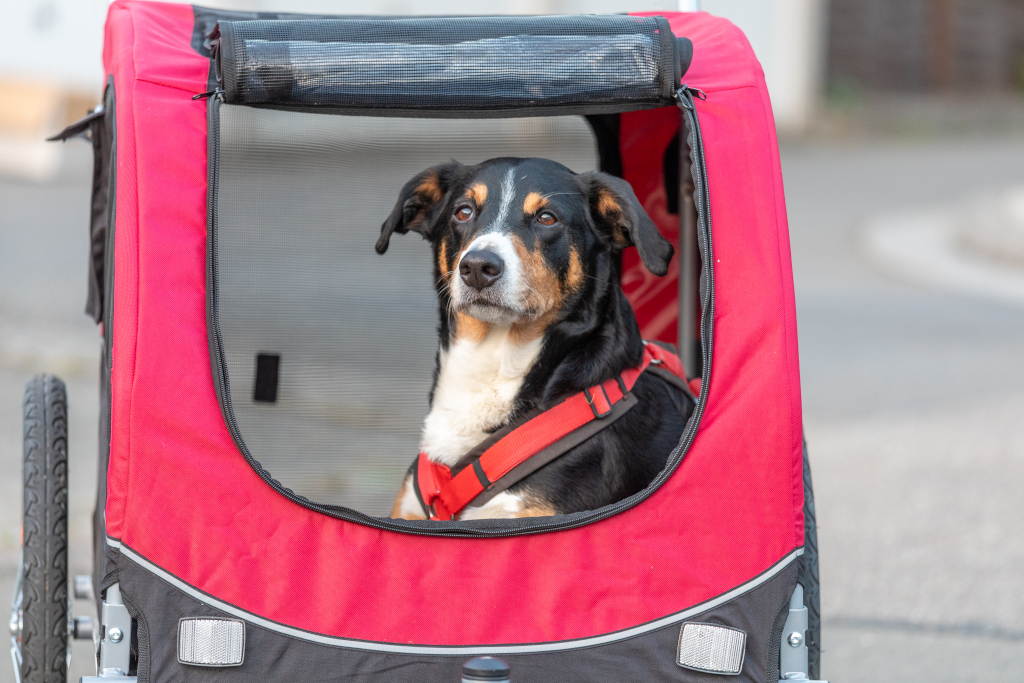
We’ve talked a lot about what makes an excellent furry biking companion and what to bring for cycling with dogs. We’ve also given you tips on keeping your four-legged friend safe while letting them run next to your bike. But what if your canine isn’t cut out for running alongside you?
And obviously, no two dogs of the same breed are the same. Some dogs are always full of beans, bursting with energy, and take to running alongside bikes like it’s their new favorite hobby. In contrast, some may not be so enthusiastic about the idea and love nothing more than taking a nap, and these couch potatoes surely won’t be too thrilled about running next to your bicycle, no matter how short the journey is. So what if your canine has everything it takes to be a great running partner in terms of breed, age, and health but isn’t too fond of the idea yet still wants to join you on your cycling adventure?
Luckily, there’s a solution for that! If you have a medium- or large-sized dog, all you need is just a dog bike trailer.
A bike trailer for dogs is essentially a carriage that you can attach to the back of your bicycle. It comes with an entry point and typically has mesh panels on the sides that allow your dog to see out and enjoy the scenery as you’re cycling. Some also come with built-in leashes, so you don’t have to worry about your pup jumping out while you’re on the move!
These trailers are a perfect solution for pooches who can’t or don’t want to run, as they allow them to sit back, relax, and enjoy the ride while being pulled along behind you. And you simply need to load your pup into the trailer, strap them up, and off you go!
There are a few things you need to consider first, though, before you go ahead and purchase one. The size of the trailer is an important factor to think about. After all, you want your pooch to be comfortable while they’re riding. If the trailer is too small, they may feel cramped and uncomfortable. And if it’s too big, they may have a lot of extra space that they don’t need and could end up getting jostled around. Other things you also need to consider before buying one include ventilation, safety features, suspension system, flooring, etc. We won’t go into the details here as we have a buying guide for bike trailers that covers all of that, be sure to check it out if you are interested.
And just like some pups don’t enjoy riding in a car, some may not take well to being towed along by a bike. So once you’ve got the perfect trailer, make sure to accustom your furry biking buddy to it before setting off on a long journey. Let them explore it and get comfortable in it first so that they don’t get too anxious or stressed when it’s time to hit the road. And ensure to take things slowly at first and gradually increase the distance and speed as your dog gets more comfortable.
Riding Dogs in a Bike Basket
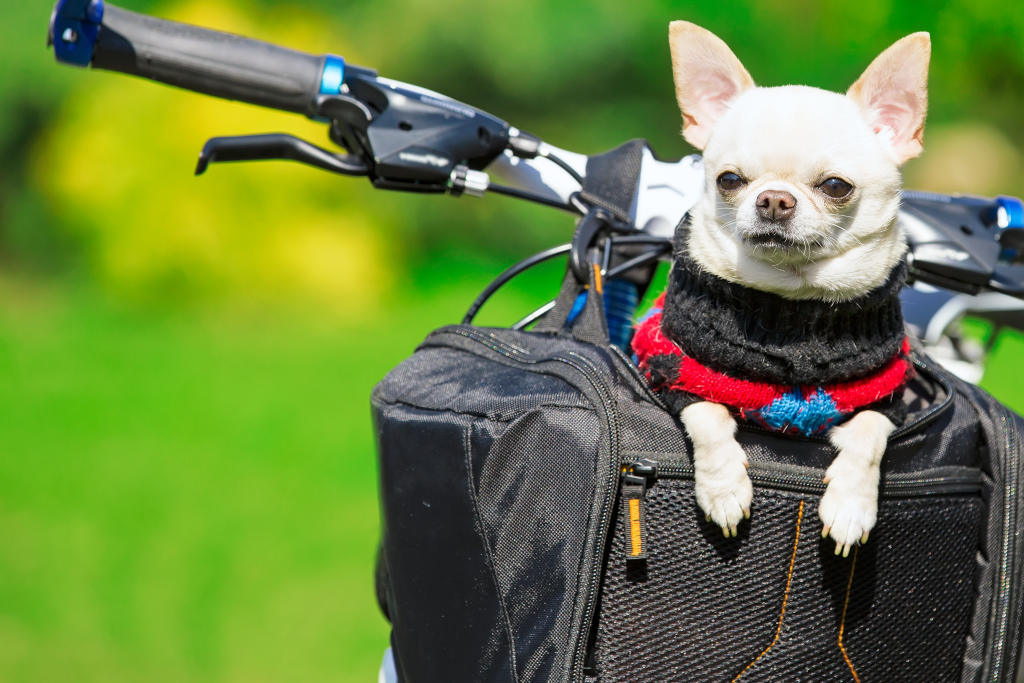
You have a lot more options for biking with small dogs, and to carry smaller pooches on a bike ride, you can opt for a dog bike basket instead of a trailer.
These baskets attach to the handlebars, allowing your pup to sit right in front of you while cycling. And that essentially means you can keep a close eye on them to ensure that they’re safe and comfortable. Some baskets even come with a cover to provide shade and keep the intense sun from beaming down on your pooch. And if you’re worried about them falling out or jumping out, most baskets have an interior safety leash that you can clip to their harness or collar to keep them secure. One thing, though, front-mounted dog bike baskets can affect balance and steering due to the extra weight added to the front of your bicycle.
Of course, there are also dog bike baskets designed to attach to your bicycle’s rear rack. Rear-mounted baskets offer more stability and security and can carry slightly heavier dogs than front-mounted baskets. The only disadvantage is that you can’t monitor your tiny canine companion as easily.
We have a detailed guide on choosing the best dog basket for bikes, so ensure to check it out before getting one for your little fur friend!
And just like bike trailers, you’ll want to introduce your canine to the basket and let them get used to it before taking them on longer rides. Start with letting them explore it and sit in it while it’s stationary. Then, once they seem okay with it, take things slowly at first by going on short rides around the block and gradually work your way up as they get more comfortable riding in the basket.
Riding Dogs in a Backpack Carrier
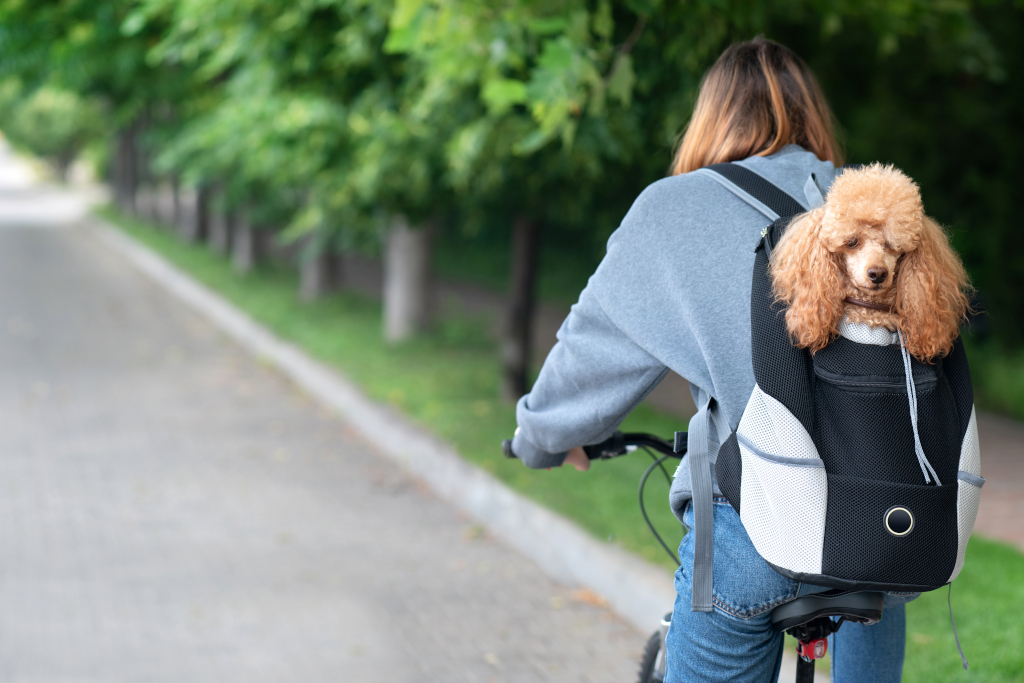
Want a cooler way to carry your doggo and look like the coolest person on the block while cycling with your pup? Dog backpack carriers let you do just that! And if you were to ask me whether bike baskets or backpack carriers for dogs are better for taking your pup on bike rides, I’d say backpack carriers, hands down! In fact, if you were to go to a bike shop and ask the same question, they would likely give you the same answer.
Why?
Because anyone who has experience with both knows that bicycle baskets make your bike top-heavy, which can really throw off your balance and make it pretty hard for you to steer, just like I mentioned earlier, even if your pup is lightweight. On the other hand, backpack carriers won’t have any of the potential issues that bike baskets have. Look, I’m not saying that dog baskets for bikes are bad. If you have a very tiny dog and only plan to go on casual bike rides, they should do just fine. But just know that there are better options out there.
Most dog backpacks these days come with plenty of features to ensure both you and your furry friend are comfortable. For instance, they often have padded shoulder straps to prevent cutting into your shoulders and an adjustable waist belt to provide extra support so that there won’t be too much strain on your back. Many of them also come with storage pockets where you can store treats, water, your phone, keys, etc., which is always handy.
Another advantage dog backpacks have over bike baskets is that they provide more protection and security for your pup. These packs usually zip or buckle shut, so there’s no need to worry about your pup wiggling out. And if you get one with a built-in leash clip, you can rest assured that they will not leap out!
Depending on the model, most pet carrier backpacks can accommodate dogs up to 25 to 30 pounds. And if you get a top-range pack like the K9 Sport Sack Rover 2, it can even carry dogs of up to 80 pounds! The only downside of dog backpacks is that they can be more expensive than bike baskets. But in my opinion, they are definitely worth the investment!
Wrapping Up
Planning a paw-fect cycling adventure with your furry friend isn’t as difficult as it may seem. You just need to determine whether your pup is better suited running alongside your bike or if they prefer to ride in a carrier.
And once you’ve got that sorted out, all that’s left to do is choose the right gear and follow the tips I shared above! And before you know it, you and your pup will be cycling like pros!
I hope you find this post helpful, and if you do, please share it with your family, friends, or anyone else who might enjoy biking with their doggo! Thanks for reading!

Recommended Reads:

